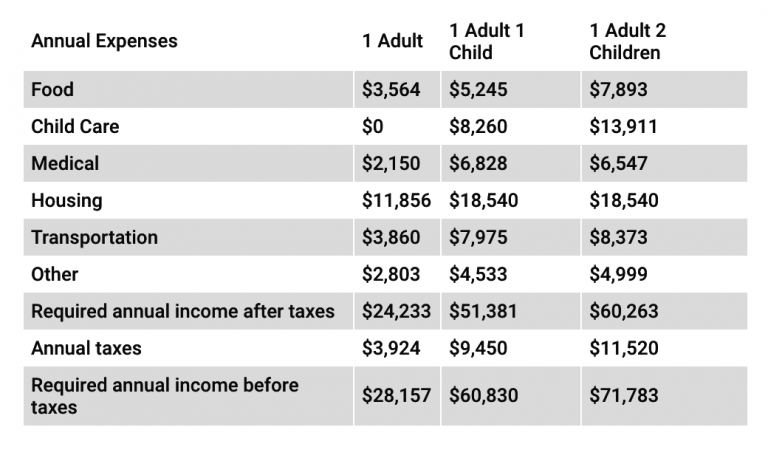Wages & the Gig Economy in Los Angeles
For most Los Angeles workers, the wages they earn each month go directly toward making ends meet – paying their rent on time, putting food on the table and keeping up with monthly bills. But, are the wages workers earn enough? A recent survey found that 78% of full-time American workers are living paycheck-to-paycheck. Workers need a steady paycheck more than ever before, and too many workers aren’t earning enough to get by.
How Much do L.A. Workers Earn?

The Longitudinal Employer-Household Dynamics (LODES) data from the U.S. Census Bureau categorizes monthly wages into three tiers: workers earning less than $1,250 a month, workers earning between $1,251-$3,333 a month, and workers earning more than $3,333 a month. These data offer interesting insights into how much LA workers are earning.
As of 2014, Los Angeles County had a total of 4,119,592 workers. The percentage of workers earning more than $3,333 a month has been steadily increasing since 2002 from 27% of all workers to 39% in 2014. Further, more than 61% of workers in Los Angeles County are earning less than $3,333 a month, and nearly 27% of all workers are earning less than $1,250 a month, which calculates to less than $15,000 a year. That means one in four workers are dangerously close to – or fall below – the 2018 Federal Department of Health and Human Services poverty guideline for individuals of $12,140 a year.
Where are the Top Earners?
The highest concentration of workers earning more than $3,333 a month is along the coast in Santa Monica, Manhattan Beach, Redondo Beach and Venice, as well as neighborhoods in West Los Angeles such as West Hollywood, Brentwood, and Beverly Hills. These communities also have the highest concentration of workers with a college degree and the majority of workers self-identify as white.
In contrast, large swaths of South Los Angeles, Southeast Los Angeles and the Northern San Fernando Valley have a higher concentration of workers earning less than $3,333 a month. These communities also have fewer workers with a college degree and are more diverse with large Black and Latino population.
Will the Minimum Wage Increase Help the Low Earners?
Californians earning the state’s minimum wage received a raise to $11 an hour effective January 1st, 2018. Workers will continue to earn a $1 increase each year until they reach $15 in 2022.* At $15 an hour, working full-time 40 hours a week, workers will earn approximately $2,400 each month or $28,880 annually, before taxes.
Although this is a significant increase, it is not nearly enough to qualify as a living wage if a worker has a child. According to MIT’s living wage calculator, a single adult in Los Angeles has typical annual expenses that require earning at least $28,157 before taxes to make ends meet, but would need to make more than $60,830 if they have a child. Workers earning exactly $3,333 a month would earn an annual salary of $39,996 before taxes, which is still not enough to support a household with one or more children.




Chart Source: MIT Living Wage Calculator
*According to the State of California Department of Industrial Relations, the minimum wage will increase to $15 by 2022 for employers employing 26 or more employees. This increase will be delayed one year for employers employing 25 or fewer employees.
The Gig Economy

Many Angelenos are foregoing a typical 9 to 5 job for a “gig” — a term for freelance independent contract work that connects workers to jobs through a digital platform. The most common gigs are driving for ridesharing services such as Uber or Lyft, performing small jobs such as cleaning and repairs through TaskRabbit, or renting a room or space via Airbnb. Freelance work offers workers the flexibility of managing their own time at the expense of little to no benefits or job security.
The lure of flexibility and the ease of using these digital platforms has triggered a major spike in the number of freelance workers in Los Angeles. The Brooking Institution analyzed payroll data for the Los Angeles Metropolitan Area, which includes Los Angeles, Anaheim, and Long Beach, and found freelance employment increased by 136% from 2012-2014. According to a recent report by Alan Krueger, Bendheim Professor of Economics and Public Affairs at Princeton University, and Jonathan Hall, Head of Policy Research at Uber, Uber has more than 20,000 drivers in Los Angeles, more than any other City in America. The same report analyzed an October 2014 snapshot of median earnings for Los Angeles area UberX drivers. According to the report, 59% of Los Angeles drivers drive between 1-15 hours and earn a median hourly earning of $16.37, while only 8% of drivers are working between 35-40 hours and earn a median hourly earning of $17.07.
Recent reports from freelance workers in the gig economy have identified cycles of dependence, lower pay and increased competition. The Guardian documented the experiences of several Los Angeles Uber drivers that are homeless and live out of the same cars they use for work. Many of these drivers were locked into lease agreements with Uber that could add up to more than $1,000 a month for a 4-door sedan and insurance, add in maintenance and gasoline, and a significant portion of an Uber driver’s earnings were spent on their vehicle. A few months after these reports were uncovered by the Guardian, the Wall Street Journal and other media outlets, Uber announced it would no longer lease vehicles and would focus on driver retention.
Opportunities to Grow

The cost of living in Los Angeles is high, and wages are failing to keep up causing many workers to struggle to get by. Our region must continue to invest in job training and higher education to increase the number of workers in the region’s highest-paid industries such as engineering, technology, healthcare, and science.
Los Angeles Trade Technical College (LATTC), one of ten Los Angeles Community Colleges, has become a trailblazer under the leadership of President Larry Frank in providing a variety of innovative career pathways to its students. LATTC has more than 9 different pathways with 97 programs of study including advanced transportation and manufacturing, applied science, health and related sciences, and design and media arts. In addition to an education in a burgeoning field, LATTC partners with local employers and industries to provide students with internships and work experience to gain the valuable skills they will need to be competitive in the job market.
The Los Angeles College Promise is an investment that ensures graduating high school seniors have the opportunity to begin their path toward a college degree or workforce certificate with a year of free tuition at a Los Angeles Community College, priority enrollment in required math and English courses and professional guidance on financial aid and educational planning. The program is a partnership between the Los Angeles Community College District, Los Angeles Unified School District, the Los Angeles Chamber of Commerce and Los Angeles Mayor Eric Garcetti.
Millions of Angelenos are working hard every day to meet their needs and reach their goals. Investing in our workers through education and job training for the jobs of tomorrow will make Los Angeles stronger, wealthier and more resilient.


Juan Lopez
Juan Lopez is a first-generation American, a proud product of public schools and the first in his family to graduate college. Juan is currently pursuing a Masters in Public Administration at the University of Southern California Price School of Public Policy. He attended Long Beach City College and transferred to the University of Oregon where he graduated with a BA in Political Science. He most recently served as Director of Technology and Innovation in the Office of Los Angeles City Controller Ron Galperin. As a forward-thinking public servant, Juan focused on cutting red-tape, making government more efficient and making a meaningful difference in the lives of Angelenos. Juan loves hiking, writing, breakfast burritos, and road trips.
Sources
Bhuiyan, Johana. “Uber Is Closing down Its Car-Leasing Program Because It Was Losing More Money than Expected.” Recode, Recode, 27 Sept. 2017, https://www.vox.com/2017/9/27/16375072/uber-xchange-car-leasing-losses.
Bureau, US Census. “Data.” Poverty Thresholds, U.S. Census Bureau, 11 Aug. 2017, www.census.gov/data/tables/time-series/demo/income-poverty/historical-poverty-thresholds.html.
Dickler, Jessica. “Most Americans Live Paycheck to Paycheck.” CNBC, CNBC, 30 Aug. 2017, www.cnbc.com/2017/08/24/most-americans-live-paycheck-to-paycheck.html.
Enforcement, Division of Labor Standards. “Minimum Wage.” Department of Industrial Relations, State of California, Dec. 2016, www.dir.ca.gov/dlse/faq_minimumwage.htm.
Glasmeier, Amy K. “Living Wage Calculation for Los Angeles County, California.” Living Wage Calculator – Living Wage Calculation for Los Angeles County, California, Massachusetts Institute of Language, 2018, livingwage.mit.edu/counties/06037.
Green, Carla, and Sam Levin. “Outside in America Homeless, Assaulted, Broke: Drivers Left behind as Uber Promises Change at the Top.” The Guardian, The Guardian, 17 June 2017, www.theguardian.com/us-news/2017/jun/17/uber-drivers-homeless-assault-travis-kalanick.
Hall, Jonathan, and Alan Krueger. “An Analysis of the Labor Market for Uber’s Driver-Partners in the United States .” s3.amazonaws.com/uber-static/comms/PDF/Uber_Driver-Partners_Hall_Kreuger_2015.pdf.
Hathaway, Ian, and Mark Muro. “Tracking the Gig Economy: New Numbers.” Brookings, Brookings Institutions, 25 Oct. 2016, www.brookings.edu/research/tracking-the-gig-economy-new-numbers/.
Photo Attributions
Cover Photo: Photo courtesy of Istock/kali9
Photo 1: Photo courtesy of Istock/Drazen_
Photo 2: Photo courtesy of Istock/irina88w
Photo 3: Photo courtesy of Istock/fcafotodigital
Photo 4: Photo courtesy of Istock/Pakomartinez
Photo 5: Photo courtesy of Istock/Mlenny
Photo 6: Photo courtesy of Istock/monkeybusinessimages
Photo 7: Photo courtesy of Istock/FatCamera

